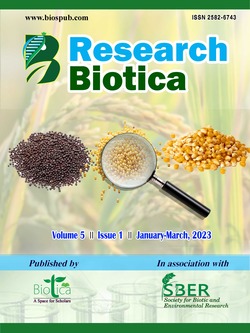
Conservation of Natural Habitat for Sustaining Indigenous Ornamental Fish Stock: Prime Need of the Hour amidst Development and Industrialization
Banlam J. Marbaniang*
ICAR-Central Institute of Fisheries Education, Versova, Andheri (W), Mumbai, Maharashtra (400 061), India
Venerability Dhar
ICAR-Central Institute of Fisheries Education, Versova, Andheri (W), Mumbai, Maharashtra (400 061), India
Supratim Malla
College of Fisheries, Central Agricultural University (I), Lembucherra, West Tripura, Tripura (799 210), India
Debojit Dekari
College of Fisheries, Central Agricultural University (I), Lembucherra, West Tripura, Tripura (799 210), India
Nayan Chouhan
College of Fisheries, Central Agricultural University (I), Lembucherra, West Tripura, Tripura (799 210), India
DOI: https://doi.org/10.54083/ResBio/5.1.2023/07-10
Keywords: Biodiversity, Conservation, Fisheries, Strategies, Sustainability
Abstract
The rapidly increasing developmental activities around the globe are ultimately compromising with the existence of rich biodiversity in the ecosystem. Development at any cost should never affect the flora and fauna of a particular geographical location adversely. Wild fish stocks are getting depleted due to the anthropogenic activities carried out by man which disrupts their natural habitat, feeding and breeding grounds due to the output and waste generated from them which proves to be detrimental to the fish biodiversity. Moreover, 85% of ornamental fish according to studies, are caught from the wild for marketing purposes and if the natural habitat remains the sole source of exploitation, sooner or later the stock may get completely vanished. In order to sustain and maintain a healthy and rich environment, the organisms dwelling in it should not be stressed in any way so that they can normally thrive and enhance its population to conserve the environment because for centuries they have co-existed with that environment through which a positive mutual correlation has been created which is necessary to achieve the goal of a healthy and rich diversity. Therefore, necessary and concrete measures and strategies such as standardization of captive breeding techniques, ranching, regulatory measures etc. should be devised and implemented to achieve the said goal.
Downloads
not found
Reference
Agardy, T., di Sciara, G.N., Christie, P., 2011. Mind the gap: Addressing the shortcomings of marine protected areas through large scale marine spatial planning. Marine Policy 35(2), 226-232. DOI: https://doi.org/10.1016/j.marpol.2010.10.006.
Aziz, M.S.B., Hasan, N.A., Mondol, M.M.R., Alam, M.M., Haque, M.M., 2021. Decline in fish species diversity due to climatic and anthropogenic factors in Hakaluki Haor, an ecologically critical wetland in northeast Bangladesh. Heliyon 7(1), e05861, DOI: https://doi.org/10.1016/j.heliyon.2020.e05861.
Given, D., Meurk, C., 2000. Biodiversity of the urban environment: the importance of indigenous species and the role urban environments can play in their preservation. In: Urban Biodiversity and Ecology as a Basis for Holistic Planning and Design. (Eds.) Stewart, G.H., Ignatieva, M.E. Lincoln University, Lincoln, New Zealand. pp. 22-33.
Reid, G.M., 1995. Conserving fishes and aquatic invertebrates: Chester Zoo Aquarium and the FAI Taxon Advisory Group. International Zoo Yearbook 34(1), 52-59. DOI: https://doi.org/10.1111/j.1748-1090.1995.tb00657.x.
Mahapatra, B.K., Lakra, W.S., 2014. Ornamental fishes of East Kolkata wetland, West Bengal, India. IJSR Zoology 3(12), 406-408.
Moyle, P.B., Yoshiyama, R.M., 1994. Protection of aquatic biodiversity in California: A five-tiered approach. Fisheries 19(2), 6-18. DOI: https://doi.org/10.1577/1548-8446(1994)019<0006:POABIC>2.0.CO;2.
Moyle, P.B., 1996. Potential aquatic diversity management areas. Chapter 57. In: Sierra Nevada Ecosystem Project: Final Report to Congress. Vol. II. Assessments and Scientific Basis for Management Options. Davis: University of California, Centers for Water and Wildland Resources. pp. 1493-1502.
Pandey, P.K., Mandal, S.C., 2017. Present status, challenges and scope of ornamental fish trade in India. In: Conference: Aqua Aquaria India 2017. Mangalore, India. p. 10.
Philippart, J.C., 1995. Is captive breeding an effective solution for the preservation of endemic species? Biological Conservation 72(2), 281-295. DOI: https://doi.org/10.1016/0006-3207(94)00090-D.
Raja, K., Aanand, P., Padmavathy, S., Sampathkumar, J.S., 2019. Present and future market trends of Indian ornamental fish sector. International Journal of Fisheries and Aquatic Studies 7(2), 6-15.
Rajagopal, S., Sethnarayanan, D., 2006. Conservation of marine ornamental fishery resources along Gulf of Mannar through aquaculture. In: Compilation of Research papers, National Research & Monitoring Moderation Workshop. Volume 1. (Eds.) Melkani, V.K., Naganathan, V., Maheswarai, R.U. 15-16th, Dec 2006, Madurai. pp. 64-71.
Sivakumar, K., Mathur, V.B., Choudhury, B.C., 2012. Marine protected areas network in India: progress in achieving Aichi targets. In: Abstracts of 16th Meeting of Subsidiary Body on Scientific, Technical and Technological Advice. 30th April-5th May 2012, Montreal, Canada. pp. 78-79.
Sonak, S., Pangam, P., Giriyan, A., 2008. Green reconstruction of the tsunami-affected areas in India using the integrated coastal zone management concept. Journal of Environmental Management 89(1), 14-23. DOI: https://doi.org/10.1016/j.jenvman.2007.01.052.
Swain, S.K., Ail, S.K.S., Jena, S.K., Bairwa, M.K., Sahoo, S.N., 2021. Preference of breeding substratum, embryonic development and seed production of honey gourami, Trichogaster chuna (Hamilton, 1822) - An indigenous ornamental fish in demand. Aquaculture 542, 736874. DOI: https://doi.org/10.1016/j.aquaculture.2021.736874.
Thilsted, S.H., Roos, N., Hassan, N., 1997. The role of small indigenous fish species in food and nutrition security in Bangladesh. Naga, ICLARM Quarterly 20(3/4), 82-84. URL: https://hdl.handle.net/20.500.12348/2658.
Travis, J., Coleman, F.C., Grimes, C.B., Conover, D., Bert, T.M., Tringali, M., 1998. Critically assessing stock enhancement: An introduction to the Mote Symposium. Bulletin of Marine Science 62(2), 305-311.
